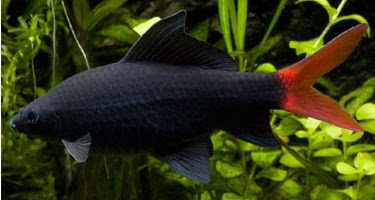Scientific Name:- Epalzeorhynchus (Labeo) bicolor
Alternative Name:- Redtailed Black Shark, Fire Tail, Red Tailed Labeo
Basic Info
The Red Tail Shark has a dark black body, and bright red tail. There
is a clear dividing line between the red and dark colors, which is
quite striking. At maturity, these fish usually reach lengths between
three and four inches (seven to ten centimeters). The lips of the Red
Tail Shark are equipped with two barbs, which aid them in consuming
algae. They are not true sharks; rather, they belong to a family of
algae eating fish. Juvenile Red Tail Sharks tend to be paler in color
than adults, who become very dark with age. Juveniles may have white
dorsal spots or white edged fins, coloring they lose as they mature.
A lid is essential on an aquarium housing Red Tail Sharks. An
aquarium of more than 50 gallons in volume is often used. Water
temperature should be maintained between 72 and 79 degrees Fahrenheit
(22and 26 degrees Celsius). A pH level of 7.5 and 10 degrees of
hardness are recommended. Decorations should be provided for your Red
Tail Shark to allow it territorial markers and hiding places, although
it is preferred that these are placed about the sides of the
enclosure, leaving the center for swimming activity. A smooth substrate,
perhaps with a few smooth stones to harbor algal growth, is
recommended. Cleanliness is of particular importance, as these fish
are sensitive to nitrites. Red Tail Sharks will not tolerate
conspecifics and may eat small fish. They should only be kept with
fish of roughly equal size and temperament, and may become more
intolerant of other fish as they age. The Red Tail Shark's diet should
consist of much vegetative matter, since it is of the family of algae
eaters. Juveniles lacking plant material in their diets are often
stunted in growth or poorly colored. Zucchini, spinach, lettuce, and
algae should all be staples. Live or frozen bloodworms, glassworms,
earthworms, fruit flies, and brine shrimp should all be offered.
Frozen plankton and vegetable diet or live tubifex worms can also be
offered. Red Tail Sharks that are pale in color may be unhealthy or
suffering from chronic stress. Breeding Male Red Tail Sharks have
pointed dorsal fins, whereas the dorsal fins of females end at right
angles. Although it is possible to breed Red Tail Sharks in captivity,
it is rather difficult due to the level of intolerance these fish
show for conspecifics. It is usually a bit easier to achieve breeding
in large, heavily planted, outdoor ponds. Between 30 and 40 eggs will
be deposited, usually in rocky crevices or cracks, where the male Red
Tail Shark guards them. Normally, Red Tail Shark eggs hatch within two
to three days, and by the time they are about two days old, the fry are
able to swim freely. At one half inch in length, the fry will begin
to acquire adult coloration, which develops more fully by the time
they are about eight weeks old.
Habitat
Fresh water fish - Their preferred habitats were those of overgrown waterways with rocky bottoms and strong currents.
Behavior
Although most Red Tail Sharks are kept alone, some people have had
success introducing these fish into communities where other more
peaceful fish would not thrive. The strikingly beautiful Red Tail
Shark is thus able to fill a niche in certain community tanks, but is
also brilliant when given a tank to itself. The Red Tail Shark usually
remains in the middle to bottom regions of its enclosure. In these
areas, it stakes out a territory using decorations as landmarks. Often,
several territories will be established and invading fish may be
attacked. Red Tail Sharks do not tolerate other fish of their species
in their enclosures. They may even go after fish larger than they are,
stressing these tank mates. Fish with red markings are persecuted
most frequently. For such reasons, most people keep Red Tail Sharks
with large equally aggressive fish, or they keep solitary Red Tailed
Sharks. These fish spend long periods of time in hiding, following
these hiatuses with periods of frenetic activity, and have been known
to repeatedly leap out of water into the air.
Origin
Thailand
History
Red Tail Sharks are native to Thailand, though they are thought to be
extinct in the wild due to their heavy demand in the pet trade.





No comments:
Post a Comment